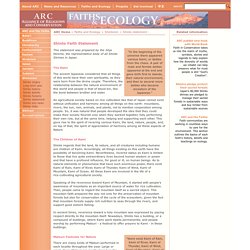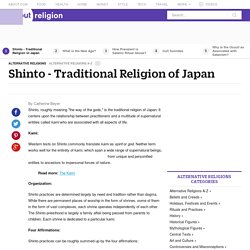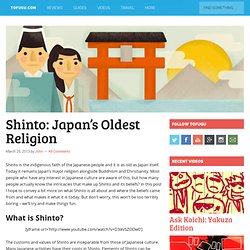

Shinto Documents. ARC - Faiths and ecology - Shinto Faith Statement. This statement was prepared by the Jinja Honcho, the representative body of all Shinto Shrines in Japan.

The Kami The ancient Japanese considered that all things of this world have their own spirituality, as they were born from the divine couple. Therefore, the relationship between the natural environment of this world and people is that of blood kin, like the bond between brother and sister. An agricultural society based on rice cultivation like that of Japan cannot exist without unification and harmony among all things on this earth: mountains, rivers, the sun, rain, animals, and plants, not to mention cooperation among people. So, it was natural that people developed the idea that they could make their society flourish only when they worked together, fully performing their own role, but at the same time, helping and supporting each other.
國學院デジタルミュージアム. Shinto - Traditional Religion of Japan. Shinto, roughly meaning "the way of the gods," is the traditional religion of Japan.

It centers upon the relationship between practitioners and a multitude of supernatural entities called kami who are associated with all aspects of life. Kami: Western texts on Shinto commonly translate kami as spirit or god. Neither term works well for the entirety of kami, which span a wide range of supernatural beings, from unique and personified entities to ancestors to impersonal forces of nature. Read more: The Kami Organization: Shinto practices are determined largely by need and tradition rather than dogma. Four Affirmations: Shinto practices can be roughly summed up by the four affirmations: Tradition and family Love of nature – The kami are an integral part of nature. Shinto Texts: Many texts are valued in the Shinto religion. Shinto itself has existed for more than a millennium before that point in time. Relationship with Buddhism and Other Religions: Yale Forum on Religion and Ecology. Shinto Shinto and Ecology: Practice and Orientations to Nature Rosemarie BernardHarvard University IntroductionShinto (or kannagara no michi, literally “the way of the deities”) is Japan’s indigenous religion.

Shinto refers to diverse and localized religious beliefs, ritual practices, and institutions. On the one hand, Shinto encompasses local community practices, while on the other it also includes the elaborate and highly structured ceremonial practices of the imperial institution and, in earlier historical periods, of the state. Today, there are more than 80,000 Shinto shrines that are scattered all over the Japanese archipelago. SHINTO. Religions of the world Sponsored link.

Brief history of Shinto: Shinto is an ancient Japanese religion. Starting about 500 BCE (or earlier) it was originally "an amorphous mix of nature worship, fertility cults, divination techniques, hero worship, and shamanism. " 1 Its name was derived from the Chinese words "shin tao" ("The Way of the Kami") in the 8th Century CE. At that time: The complete separation of Japanese religion from politics did not occur until just after World War II.
Unlike most other religions, Shinto has no real founder, no written scriptures, no body of religious law, and only a very loosely-organized priesthood. Shinto Basics. Religion. Religion: Shinto. Shinto Origins, Shinto History, Shinto Beliefs. Shinto: Japan’s Oldest Religion. Shinto is the indigenous faith of the Japanese people and it is as old as Japan itself.

Today it remains Japan’s major religion alongside Buddhism and Christianity. Most people who have any interest in Japanese culture are aware of this, but how many people actually know the intricacies that make up Shinto and its beliefs? In this post I hope to convey a bit more on what Shinto is all about and where the beliefs came from and what makes it what it is today. But don’t worry, this won’t be too terribly boring – we’ll try and make things fun. What is Shinto? [yframe url=' The customs and values of Shinto are inseparable from those of Japanese culture. Shinto doesn’t really have a founder or sacred scriptures or anything like that though. Since Shinto is very Japanese by nature and does not try to press others to join them, the percentage of Shintos living in this world is very small, with pretty much all of them residing in Japan. Sacred Shinto music and dance (Kagura, Japanese traditional dance)